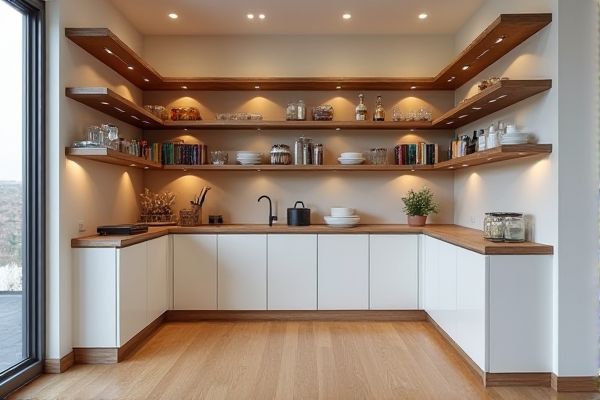
Corner shelves maximize space in tight pantry corners, offering easy access and organized storage, while L-shaped shelves provide extended storage along two walls, ideal for larger pantries with ample room. Discover which pantry shelving option best fits Your kitchen layout and storage needs by reading the detailed comparison ahead.
Table of Comparison
| Feature | Corner Shelves | L-Shaped Shelves (Pantry) |
|---|---|---|
| Design | Triangular shelves fitting into pantry corners | Two connected shelves forming an 'L' shape along adjacent walls |
| Space Utilization | Maximizes awkward corner spaces | Maximizes wall space on two adjoining walls |
| Storage Capacity | Limited to corner area; ideal for small items | Higher capacity; accommodates larger and bulkier pantry items |
| Accessibility | Items may be harder to reach in deep corners | Better accessibility with open, extended shelving |
| Installation | Easier to install in tight, confined spaces | Requires more wall space and support along two walls |
| Best Use Case | Small pantries or tight corner optimizations | Larger pantries needing organized, expansive storage |
Overview: Corner Shelves vs L-Shaped Shelves in Pantries
Corner shelves maximize unused space by fitting snugly into pantry corners, ideal for storing small jars and cans. L-shaped shelves offer more continuous storage along two adjoining walls, providing easier access and better visibility for larger items. Your choice depends on the pantry layout and the type of items you need to organize efficiently.
Space Efficiency: Maximizing Pantry Storage
Corner shelves utilize otherwise wasted corner space in your pantry, providing easy access to stored items while maximizing storage capacity. L-shaped shelves offer continuous, uninterrupted storage along two adjacent walls, creating more surface area for organizing bulkier pantry goods effectively. Both designs improve space efficiency, but corner shelves optimize tight spaces whereas L-shaped shelves enhance overall shelf capacity.
Installation Process: Complexity and Requirements
Corner shelves typically require precise measurements and wall anchors tailored to fit the unique angles of your pantry space, often demanding more complex installation tools and skills. L-shaped shelves, designed to fit snugly into corner spaces with straightforward right-angle joints, generally feature simpler mounting processes and fewer hardware requirements. Choosing between these options depends on your comfort with DIY installation and the structural support available in your pantry walls.
Accessibility: Ease of Reaching Stored Items
Corner shelves in a pantry can create hard-to-reach spaces, making it challenging to access items stored deep inside. L-shaped shelves offer improved accessibility by extending storage along two adjacent walls, allowing you to reach items more easily without bending or stretching excessively. Choosing L-shaped shelves enhances visibility and convenience for everyday pantry use.
Aesthetics: Visual Appeal and Design Flexibility
Corner shelves in pantries offer a seamless, space-saving design that enhances visual appeal by utilizing often overlooked areas, creating a streamlined and uncluttered look. L-shaped shelves provide greater design flexibility, accommodating varying pantry sizes and allowing for organized storage with easy access to items along two adjoining walls. Both options enhance pantry aesthetics by maximizing storage while contributing to a cohesive and visually pleasing layout.
Weight Capacity: Strength and Durability
Corner shelves typically offer moderate weight capacity suitable for storing lightweight pantry items, while L-shaped shelves are designed to support heavier loads due to their reinforced structure and extended surface area. The durability of L-shaped shelves often surpasses that of corner shelves, making them a reliable choice for holding bulkier kitchen supplies and appliances. Choosing the right option depends on your pantry's storage needs and the weight of items you plan to organize.
Cost Comparison: Budget Considerations
Corner shelves generally offer a more budget-friendly option than L-shaped shelves, as their simpler design requires fewer materials and less installation time. L-shaped shelves tend to cost more due to their larger size and the additional support needed for stability in a pantry corner. Your choice should balance pantry space optimization with the available budget, prioritizing cost-effectiveness without compromising storage needs.
Customization Options: Tailoring Shelves to Your Pantry
Corner shelves in pantries offer flexible customization with adjustable heights and modular designs, maximizing often-unused spaces for storing jars and cans efficiently. L-shaped shelves provide seamless, continuous surfaces ideal for accommodating larger appliances and bulkier items, with customizable depth and tier configurations to fit specific pantry dimensions. Both options allow tailored storage solutions, but corner shelves excel in optimizing tight angles while L-shaped shelves prioritize expansive, organized accessibility.
Organization and Functionality Benefits
Corner shelves maximize pantry space by efficiently utilizing unused corners, providing easy access to frequently used items and improving overall organization. L-shaped shelves offer versatile storage options with increased surface area, allowing you to separate and categorize pantry goods for better functionality. Your pantry benefits from enhanced accessibility and optimized storage, ensuring a more organized and functional kitchen environment.
Choosing the Right Shelf for Your Pantry Needs
Corner shelves maximize unused space in small pantries by fitting snugly into tight corners, offering easy access to frequently used items. L-shaped shelves provide more extensive storage along two walls, ideal for larger pantries that require organized layering of canned goods and kitchen supplies. Selecting the right shelf depends on pantry size, layout, and storage needs to enhance accessibility and optimize space efficiently.
 homyna.com
homyna.com